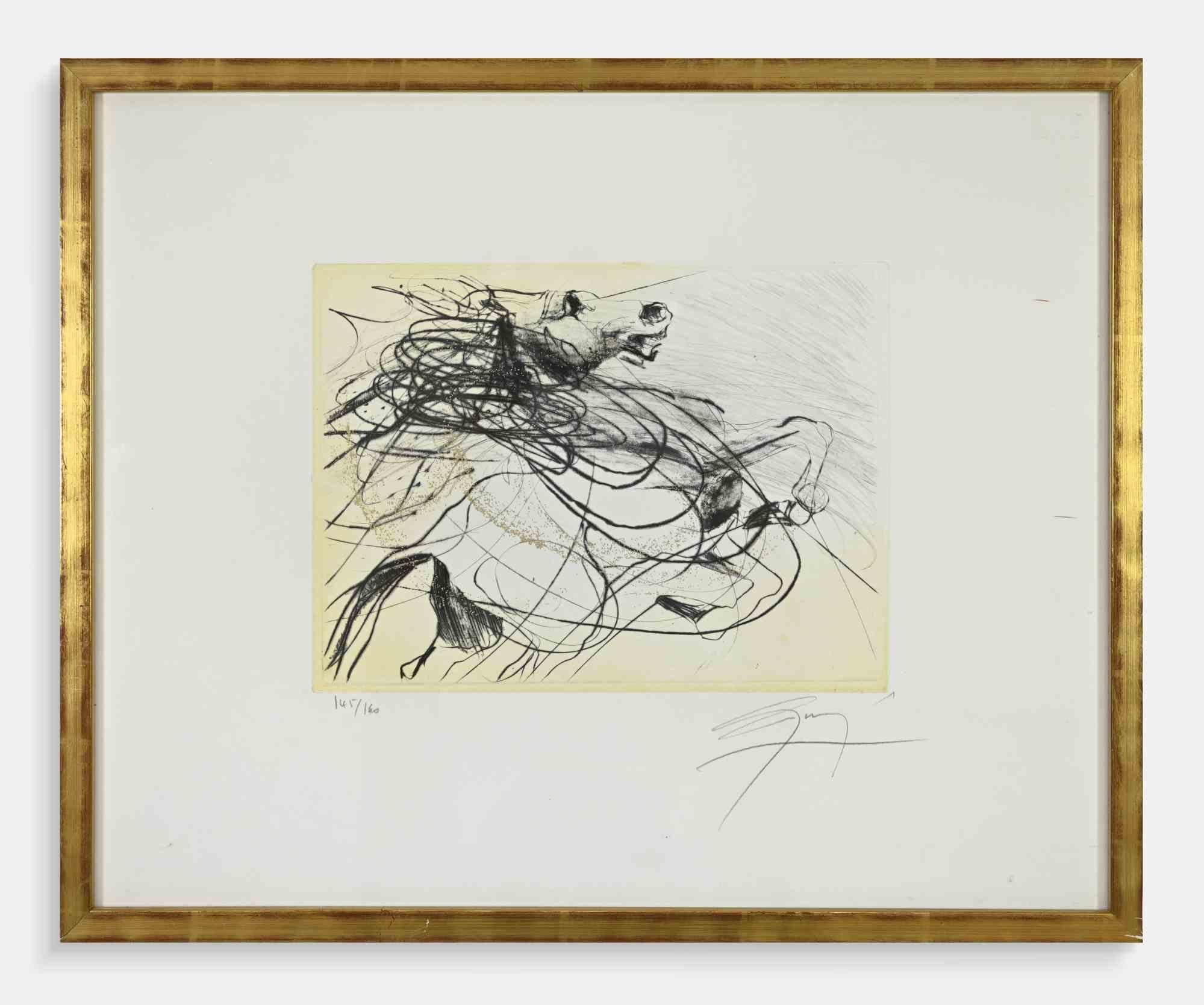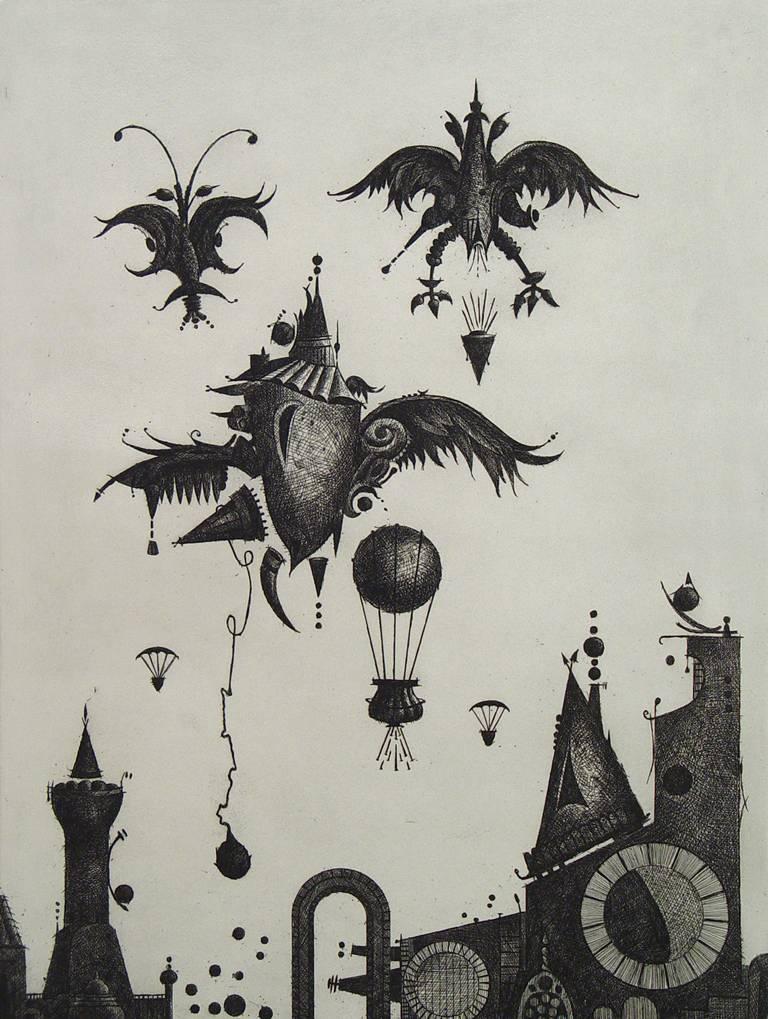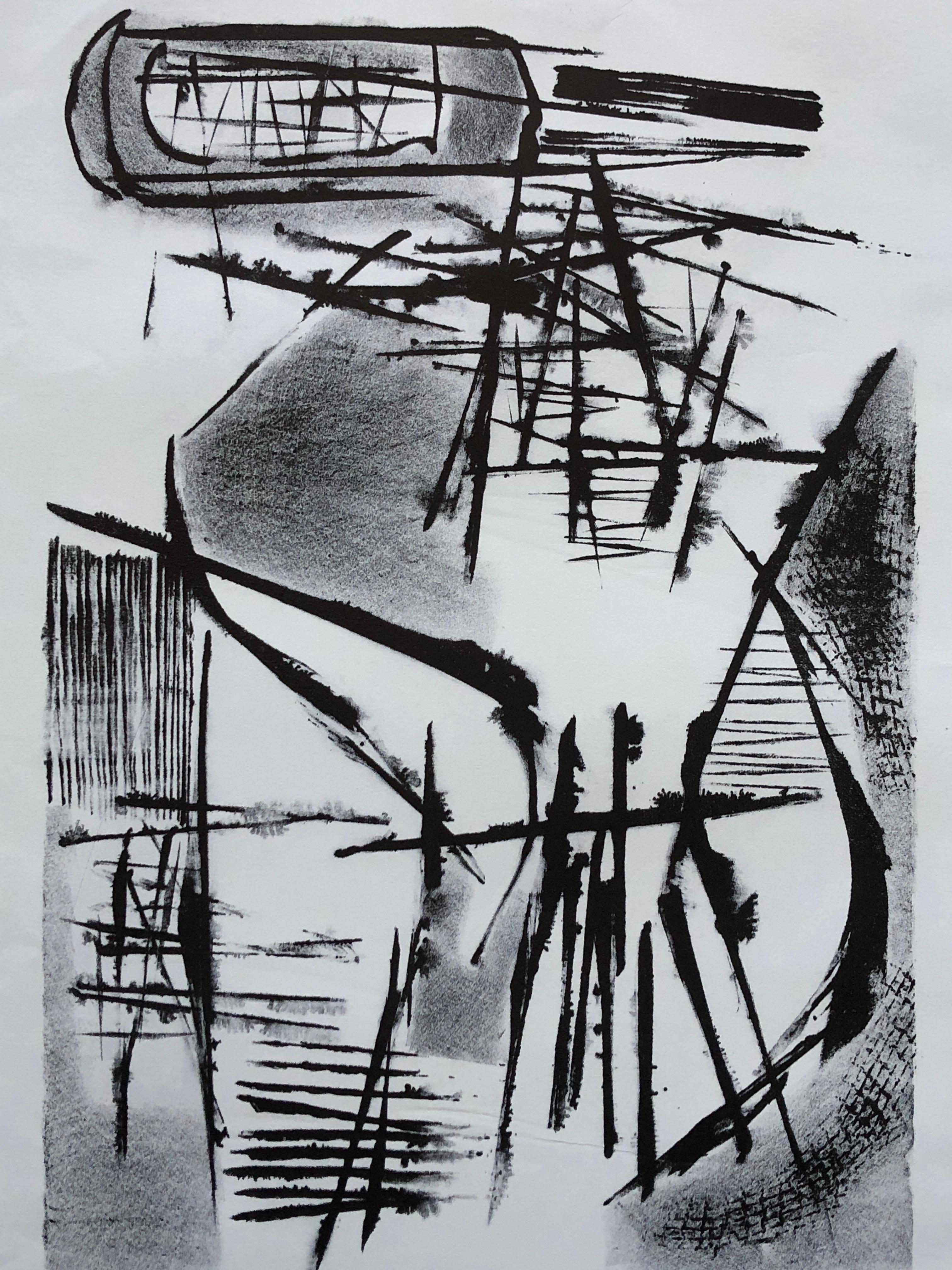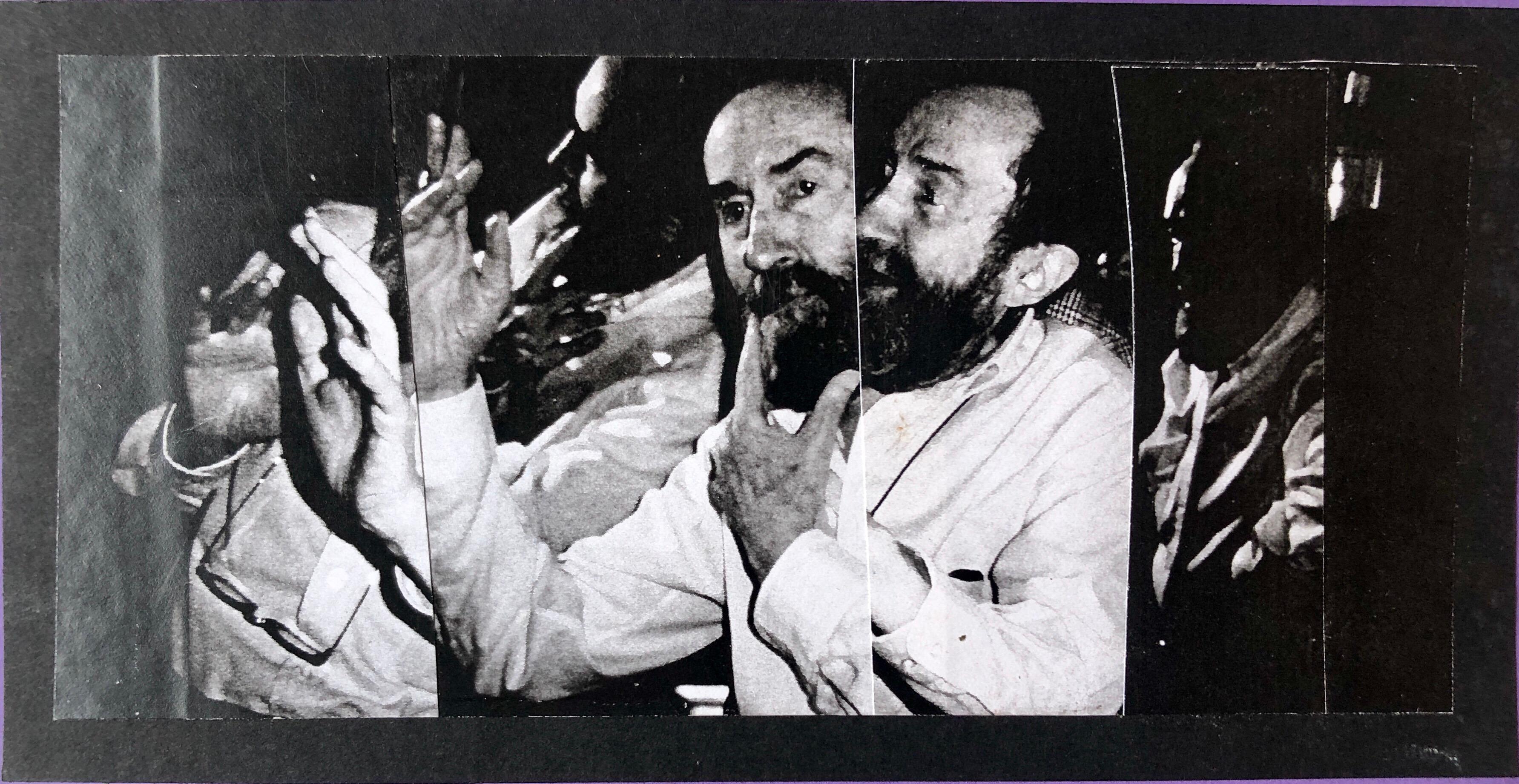Items Similar to Dry Point, Etching on Paper, Black color by Modern Indian Artist “In Stock”
Want more images or videos?
Request additional images or videos from the seller
1 of 5
Amitabh SenguptaDry Point, Etching on Paper, Black color by Modern Indian Artist “In Stock”
About the Item
Amitabh Sengupta - Dry Point - 25.5 x 19.5 inches (unframed size)
Etching on Paper , 2012
Inclusive of shipment in roll form.
Style : In Amitabh SenGupta's works TIME is depicted in various metaphors. As in the remains of rock-cut shrines or shelters, the Haveli door, the walls or a seascape, they all carry the mark of TIME - the texture of sun and wind, rain and corrosion and so on. Objects of past, and the objects of now, all stand within the frame of present. The meaning of past and present seemed to have merged in a zone of real existence - within the space and time of the artist's experience. Again as metaphor of time, the element of myth enters in Amitabh's works as often, as if to merge past into the present.
Amitabh uses oil in a modernists' way of classical manner, layers after layer, and often using the effect of the under layer. The major environment he likes to create on the canvases has an imposing feeling of reality that invariably merged into an unreal zone. The unknown elements are vital as they take real objects into a sense of continuity and motion.
About the Artist and his work :
Born : 1941.
Education :
1963 - Graduated from the Government College of Art and Craft, Kolkata.
1966-68 - Received French Government scholarships to study painting and printmaking at Ecole des Beaux-Arts, Paris.
1981 - Ed. M, State University of New York, Buffalo.
1977-1988 - Taught at two universities in Nigeria.
Awards :
1975 - President's Award in Painting, All India Fine Arts and Crafts Society, New Delhi.
Collections : President's House, Lagos, Nigeria; Lalit Kala Akademi and National Gallery of Modern Art, New Delhi; Taj Group of Hotels.
- Creator:Amitabh Sengupta (1941, Indian)
- Dimensions:Height: 25.5 in (64.77 cm)Width: 19.5 in (49.53 cm)Depth: 1 in (2.54 cm)
- Medium:
- Movement & Style:
- Period:
- Condition:
- Gallery Location:Kolkata, IN
- Reference Number:1stDibs: LU60439424682
About the Seller
4.9
Vetted Seller
These experienced sellers undergo a comprehensive evaluation by our team of in-house experts.
Established in 2004
1stDibs seller since 2017
118 sales on 1stDibs
Typical response time: 21 hours
- ShippingRetrieving quote...Ships From: Kolkata, India
- Return PolicyA return for this item may be initiated within 7 days of delivery.
More From This SellerView All
- Early Horses, Charcoal on Paper by Indian Artist Sunil Das "In Stock"By Sunil DasLocated in Kolkata, West BengalSunil Das - Early Horses, Charcoal on paper - 19 x 29 inches (unframed size) Free Shipping Without Frame Sunil Das (1939-2015) was a Master Modern Indian Artist from Bengal. Extrem...Category
1960s Modern Animal Paintings
MaterialsPaper, Charcoal
- Untitled, Digital Graphics on Paper by Modern Indian Artist “In Stock”By Amitabh SenguptaLocated in Kolkata, West BengalAmitabh Sengupta - Untitled - 13 x 19 inches (unframed size) Digital Graphics on Paper Inclusive of shipment in roll form. Style : In Amitabh SenGupta's works TIME is depicted in va...Category
2010s Modern Abstract Prints
MaterialsDigital, Paper
- How Does Your Garden Grow , Etching on Paper, by Modern Master Artist "In Stock"Located in Kolkata, West BengalAnupam Sud - Etching on Paper How Does Your Garden Grow Edition 2 of 20 14.5 x 17.7 inches (Artwork size) & Paper Size 22.5 x 29.5 inches 2005 ( Unframed &...Category
Early 2000s Modern Figurative Prints
MaterialsArchival Paper, Etching
- Night Call : Gorgeous work by Amitaha Banerjee in Etching on paperBy Amitabha BanerjeeLocated in Kolkata, West BengalAmitabha Banerjee - Night Call - 12.5 x 15.5 inches ( unframed size) Etching on paper Inclusive of shipment in roll form. About the Artist and his work : Born : In 1929 born in Bari...Category
Early 2000s Modern Figurative Prints
MaterialsPaper, Etching
- Untitled, Intaglio, Etching on Paper, Modern Indian Artist "In Stock"By Laxma GoudLocated in Kolkata, West BengalK. Laxma Goud - Untitled, Intaglio - 11 x 9 inches (unframed size) Etching on paper, 2014 Style : Goud displays versatility over a range of mediums, from printmaking, drawing, watercolour, gouache and pastels to glass painting and sculpture in bronze and terracotta. Over the many years of his artistic career, he is known to have moved from one medium to another with élan. Fellow artist T. Vaikuntam, in one of his interviews, reminisces that it was Laxma Goud who introduced him to the art of sketching and made him aware of the possibilities of this medium. When one looks at Goud’s work, rustic, raw, and potent might be the first words that come to mind. His portraits of men and women represent the dynamic Indian ethos rather than particular individual identities. A recurrent theme with the artist is that of the erotic, treated as an active and powerful aspect of male and female sexuality and existence. Goud’s work is dramatic; his protagonists are raw and vivacious in their appeal, imbibed with energy that reverberates through his strokes and textures. Most of Goud’s art is centered on the rural, recreating landscapes from his childhood as if they were frozen in time. In the artist’s later work, his figures turn softer, more introspective than brash in their outlook. About the Artist and his work : Born : 1940 in Nizampur, Andhra Pradesh...Category
2010s Modern Figurative Paintings
MaterialsPaper, Etching
- Cluster - 6By Laxma GoudLocated in Kolkata, West BengalLaxma Goud Etching on Paper 13.5 x 9.75 inches ; 2007 (each) (without frame) Inclusive of shipment in roll form. Atin Basak Tempera on Board 15 x 18 inches (without frame) Inclusi...Category
2010s Modern Figurative Paintings
MaterialsPaper, Etching
You May Also Like
- Galloping Horse - Etching by Jean-Marie Guiny - 2000sBy Jean-marie GuinyLocated in Roma, ITGalloping Horse is an artwork realized by Jean-Marie Guiny, 2000s. Etching, Edition 145/160. 40 x 50 cm ; with frame. Hand signed in the lower right part. Good condtions! J...Category
Early 2000s Modern Animal Prints
MaterialsEtching
- Le SingeBy Pablo PicassoLocated in New York, NYA very good impression of this aquatint, grattoir and drypoint. Edition of 225. Printed by Lacourière, Paris. Published by Martin Fabiani, Paris. From "Histoire Naturelle." Catalogu...Category
1930s Modern Abstract Prints
MaterialsDrypoint, Aquatint, Etching
- Mirage. 1990, zinc etching, 37x56.5 cmLocated in Riga, LVMirage. 1990, a / p., zinc etching, 37x56.5 cmCategory
1990s Surrealist Animal Prints
MaterialsPaper, Etching
- Space EaglesBy Valton TylerLocated in Dallas, TXIn The New York Times Arts in America column, Edward M. Gomez wrote of Valton Tyler, "visionary seems the right word for describing his vivid, unusual and technically refined paintin...Category
1970s Surrealist Animal Prints
MaterialsPaper, Etching
- 1950s "Abstract Bird" Stone Lithograph PrintLocated in Arp, TXFrom the estate of Jerry and Ruth Opper Abstract Bird Print 1940-1950's Stone Lithograph on Paper 17.5" x 23" Unframed Came from a portfolio of his...Category
Mid-20th Century American Modern Animal Prints
MaterialsPaper, Lithograph
- Vintage Abstract Expressionist Hyman Bloom Photo Collage Assemblage PhotographBy Martin SumersLocated in Surfside, FLThis is a unique original collage, decoupage style of Jiri Kolar, This is an exceptional artwork which was part of a collaboration between Hyman Bloom and fellow artist and his very good friend Martin Sumers. This is pencil signed by Martin Sumers. Provenance: Acquired from the Sumers estate collection. Hyman Bloom (March 29, 1913 – August 26, 2009) was a Latvian-born American painter. His work was influenced by his Jewish heritage and Eastern religions as well as by artists including Altdorfer, Grünewald, Caravaggio, Rembrandt, Blake, Bresdin, James Ensor and Chaim Soutine. He first came to prominence when his work was included in the 1942 Museum of Modern Art exhibition "Americans 1942 -- 18 Artists from 9 States". MoMA purchased 2 paintings from the exhibition and Time magazine singled him out as a "striking discovery" in their exhibition review. His work was selected for both the 1948 and 1950 Venice Biennale exhibitions and his 1954 retrospective traveled from Boston's Institute of Contemporary Art to the Albright Gallery and the de Young Museum before closing out at The Whitney Museum of American Art in 1955. In a 1954 interview with Yale art professor Bernard Chaet, Willem de Kooning indicated that he and Jackson Pollock both considered Bloom to be “America’s first abstract expressionist”, a label that Bloom would disavow. Starting in the mid 1950s his work began to shift more towards works on paper and he exclusively focused on drawing throughout the 1960s, returning to painting in 1971. He continued both drawing and painting until his death in 2009 at the age of 9 Hyman Bloom (né Melamed) was born into an orthodox Jewish family in the tiny Jewish village of Brunavišķi in what is now Latvia, then part of the Russian Empire At a young age Bloom planned to become a rabbi, but his family could not find a suitable teacher. In the eighth grade he received a scholarship to a program for gifted high school students at the Museum of Fine Arts. He attended the Boston High School of Commerce, which was near the museum. He also took art classes at the West End Community Center, a settlement house. The classes were taught by Harold Zimmerman, a student at the School of the Museum of Fine Arts, who also taught the young Jack Levine at another settlement house in Roxbury. When Bloom was fifteen, he and Levine began studying with a well-known Harvard art professor, Denman Ross, who rented a studio for the purpose and paid the boys a weekly stipend to enable them to continue their studies rather than take jobs to support their families. He took Bloom and Levine on a field trip to the Museum of Modern Art in New York, where Bloom was impressed by the work of Rouault and Soutine and began experimenting with their expressive painting styles. In the 1930s Bloom worked sporadically for the Public Works of Art Project and the Federal Art Project (WPA), He shared a studio in the South End with Levine and another artist, Betty Chase. It was during this period that he developed a lifelong interest in Eastern philosophy and music, and in Theosophy. He first received national attention in 1942 when thirteen of his paintings were included in the Museum of Modern Art (MoMA) exhibition Americans 1942: 18 Artists from 9 States, curated by Dorothy Miller. MoMA purchased two of his paintings from that exhibition, and he was featured in Time magazine. The titles of his paintings in the exhibition reflect some of his recurring themes. Two were titled The Synagogue, another, Jew with the Torah; Bloom was actually criticized by one reviewer for including "stereotypical" Jewish images. He also had two paintings titled The Christmas Tree, and another titled The Chandelier, both subjects he returned to repeatedly. Another, Skeleton (c. 1936), was followed by a series of cadaver paintings in the forties, and The Fish (c. 1936) was one of many paintings and drawings of fish he created over the course of his career. Bloom was associated at first with the growing Abstract Expressionist movement. Willem de Kooning and Jackson Pollock, who first saw Bloom's work at the MoMA exhibition, considered Bloom "the first Abstract Expressionist artist in America." In 1950 he was chosen, along with the likes of de Kooning, Pollock, and Arshile Gorky, to represent the United States at the Venice Biennale. That same year Elaine de Kooning wrote about Bloom in ARTnews, noting that in paintings such as The Harpies, his work approached total abstraction: "the whole impact is carried in the boiling action of the pigment". In 1951 Thomas B. Hess reproduced Bloom's Archaeological Treasure in his first book, Abstract Painting: Background and American Phase, along with works by Picasso, Pollock, and others. Both de Kooning and Hess remarked on Bloom's expressive paint handling, a key characteristic of Abstract Expressionist painting. As abstract expressionism dominated the American art world, Bloom became disenchanted with it, calling it "emotional catharsis, with no intellectual basis." In addition, instead of moving to New York to pursue his career, he opted to stay in Boston. As a result he fell out of favor with critics and never achieved the kind of fame that Pollock and others did. He disliked self-promotion and never placed much value on critical acclaim. Many of Bloom's paintings feature rabbis, usually holding the Torah. According to Bloom, his intentions were more artistic than religious. He began questioning his Jewish faith early in life, and painted rabbis, he claimed, because that was what he knew. Over the course of his career he produced dozens of paintings of rabbis...Category
20th Century Modern Animal Prints
MaterialsPaper, Photographic Paper
Recently Viewed
View AllMore Ways To Browse
Point Cut
Roll On Carry On
Dry Etching
Modernist Etching
Dry Point Print
Buffalo Indians
India Etching
Dry Point Etching
Etching Indian
Seascape Etching
Modernist Seascape
Seascape Oil Painting Modernist
Wall Shrine
Oil Painting Rain Paris
Taj Collection
After The Rain Paris Oil Paintings
De Jonge
Gould Richter Hummingbirds




